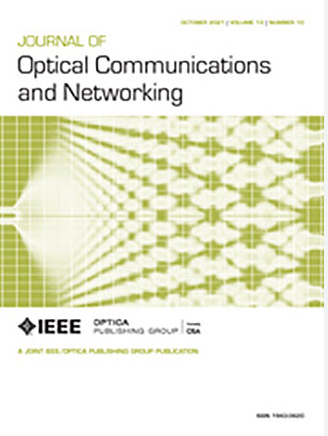Low-complexity SOP-based vibration broadband sensing and efficient recognition for stable IM/DD optical interconnects in data centers
IF 4.3
2区 计算机科学
Q1 COMPUTER SCIENCE, HARDWARE & ARCHITECTURE
引用次数: 0
Abstract
With the rapid advancement of artificial intelligence (AI) technologies, the stability of optical interconnects in data centers has become increasingly important. Vibration sensing integrated in optical interconnect systems is conducive to identifying external disturbances in optical interconnects and achieving intelligent operation and maintenance. This paper proposes an easy-integration vibration-sensing scheme based on the state of polarization (SOP) of the fiber link. This scheme combines photonic technology with low-complexity digital signal processing (DSP) to detect link vibrations, ensuring full compatibility with intensity-modulation direct-detection (IM/DD) optical interconnect systems while minimizing additional complexity. Experiments show that our proposed scheme effectively detects SOP variations across a wide frequency range (0.5 Hz to 159 kHz). Based on the sensing system, a recognition scheme leveraging the Gramian angular field analysis and convolutional neural network (CNN) is proposed to recognize four types of vibration events simulated by a robotic arm, achieving a classification accuracy of 98%. Furthermore, experimental results confirm that the sensing system can detect SOP variations even under conditions of extremely low received optical power (ROP), where the communication system becomes inoperative. The proposed scheme enables robust event detection with minimal hardware overhead, which is suitable for real-world deployment in pluggable optical modules.基于低复杂度sop的数据中心稳定IM/DD光互连的振动宽带传感与高效识别
随着人工智能技术的飞速发展,数据中心光互连的稳定性变得越来越重要。将振动传感集成到光互连系统中,有利于识别光互连中的外部干扰,实现智能运维。提出了一种基于光纤链路偏振态的易集成振动传感方案。该方案将光子技术与低复杂性数字信号处理(DSP)相结合,以检测链路振动,确保与强度调制直接检测(IM/DD)光互连系统完全兼容,同时最大限度地减少额外的复杂性。实验表明,我们提出的方案可以有效地检测宽频率范围(0.5 Hz至159 kHz)的SOP变化。在传感系统的基础上,提出了一种利用Gramian角场分析和卷积神经网络(CNN)的识别方案,对机械臂模拟的四种振动事件进行识别,分类准确率达到98%。此外,实验结果证实,即使在极低的接收光功率(ROP)条件下,该传感系统也可以检测到SOP变化,在这种情况下,通信系统无法工作。该方案以最小的硬件开销实现了鲁棒的事件检测,适合在可插拔光模块中实际部署。
本文章由计算机程序翻译,如有差异,请以英文原文为准。
求助全文
约1分钟内获得全文
求助全文
来源期刊
CiteScore
9.40
自引率
16.00%
发文量
104
审稿时长
4 months
期刊介绍:
The scope of the Journal includes advances in the state-of-the-art of optical networking science, technology, and engineering. Both theoretical contributions (including new techniques, concepts, analyses, and economic studies) and practical contributions (including optical networking experiments, prototypes, and new applications) are encouraged. Subareas of interest include the architecture and design of optical networks, optical network survivability and security, software-defined optical networking, elastic optical networks, data and control plane advances, network management related innovation, and optical access networks. Enabling technologies and their applications are suitable topics only if the results are shown to directly impact optical networking beyond simple point-to-point networks.

 求助内容:
求助内容: 应助结果提醒方式:
应助结果提醒方式:


